List of Authors
>>About this blog
Recent blog post
|
[Sumida Fireworks]
December 26, 2014 14:00
This year is another few days. In addition, a new year will begin, and I think some people will be entrusted with a new determination for the first sunrise as a start event.
I think the first sunrise from central Tokyo has become a standard from the top of high buildings and towers, but it is not necessarily seen from near the ground.
The Sumida River flows east and south sides of Chuo-ku, and there is a slight distance to the opposite bank, so there are several places where you can see sunrise without buildings on the opposite bank.
This time, referring to past photos, I dared to find a place where I could see the first sunrise from the Sumida River in Chuo-ku. This is an introduction that goes back upstream from the downstream of the Sumida River.
【1】
First of all, "Kachidokibashi".
You can see the direction of Kachidoki on the opposite bank from Tsukiji, but it is a Tokyo-like sunrise with the sun coming out between the building and the building.
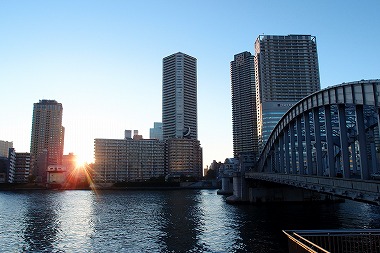
※2014/12/17 Shooting
【2】
Sunrise scenery seen in the direction of Toyosu from "Ishikawajima Park" near "Aioi Bridge".
"Ishikawajima Park" is a good place to see the first sunrise.
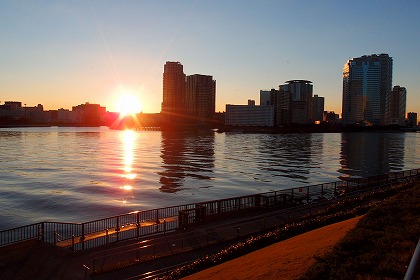
From Aioi Hashigami, the triangles of the truss bridge create a mysterious sight.
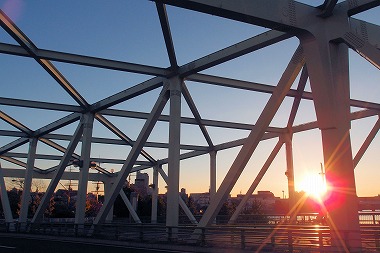
You can also see it from Nakanoshima, which is under Aioi Bridge. Watch the sunrise while fishing ... It's luxurious.
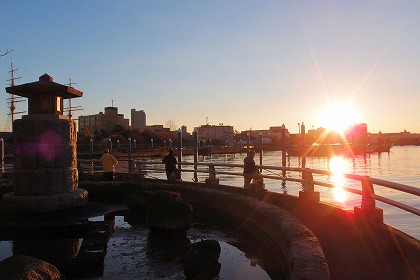 ※2014/12/6 Shooting ※2014/12/6 Shooting
【3】
You can also see the sunrise from the top of the Chuo-ohashi Bridge.
The photo is from last year (New Year's Day 2013), and although it was a little cloudy, it was the first sunrise seen through the "Messenger Statue" watching the Sumida River.
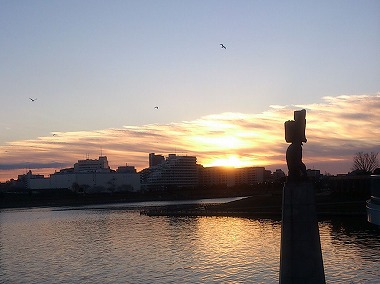
【4】
It can also be seen from "Kiyosu Bridge".
The photo is from this year (New Year's Day 2014) and is a very impressive sight. It is a bridge of important cultural properties, but the first sunrise can be said to be an important cultural property class.
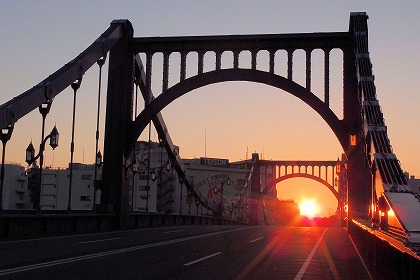 ※Be careful of traffic because you can't see it unless you go on the road for half a step. ※Be careful of traffic because you can't see it unless you go on the road for half a step.
【5】
Finally, "Shinohashi".
You can see it from the top of the bridge, but the photo shows the sunrise from the Sumida River terrace under the bridge.
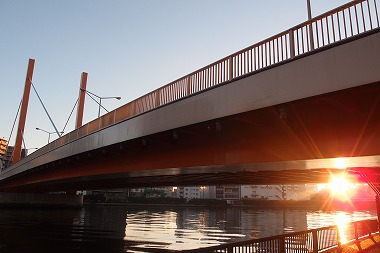 ※2014/12/13 Shooting ※2014/12/13 Shooting
This is an introduction of the first sunrise spot from the Sumida River.
The sunrise time is around 6:50. The problem will be the weather on the day, but I hope it will be clear.
There seems to be some trains running all night. It might be good to go to new year worshipping after the first sunrise.
I hope you will have the best start of the new year.
(Note: Some photos are not from the day of New Year's Day, and some may not be seen due to differences in the position of sunrise.)
<Nearest station>
【1】 Kachidokibashi: Kachidoki Station on the Oedo Line
【2】 Aioi Bridge: Tsukishima Station on the Yurakucho Line and Oedo Line
【3】 Chuo-ohashi Bridge: Tsukishima Station on the Yurakucho Line and Oedo Line
【4】 Kiyosubashi: Suitengumae Station, Kiyosumi Shirakawa Station on the Hanzomon Line / Kiyosumi Shirakawa Station on the Oedo Line
【5】 Shinohashi: Toei Shinjuku Line Hamacho Station / Morishita Station / Oedo Line Morishita Station
[kimitaku]
December 17, 2014 16:00
Harumi-dori St.
From Reimei Bridge, look at Harumi Triton Square to the left and go straight ahead.
You can see Harumi Ohashi.
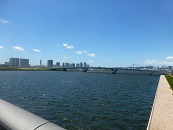
This bridge is quite steep.
Perfect for jogging and walking.
If you cross it as it is, you will head to the Toyosu district.
Yurikamome.
You can see the round Toden substation (here is a submarine cable and powered from Kisarazu) and the new market construction site (relocation of Tsukiji Market) far away.
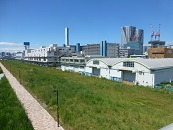
On the right hand, Harumi's warehouse group Rainbow Bridge Tokyo Bay
Takeshiba Wharf You can see Mount Fuji if it is sunny far away.
The left hand is LaLaport and Toyosu.
Once upon a time, there was a shipyard in Ishikawajima.
"Harumi Rinkai Park" has been created along the canal just before crossing Harumi Ohashi.
This park bicycle is prohibited.
Canals (sea?) even on holidays It's great for walking and jogging while watching.
Beyond that, there is also a sky tree.
 
[Sam]
December 15, 2014 14:00
 From November 1 to December 25, the Tokyo Sky Tree is carrying out the world's tallest Christmas candles and year-end limited lighting that looks like a Christmas tree. From November 1 to December 25, the Tokyo Sky Tree is carrying out the world's tallest Christmas candles and year-end limited lighting that looks like a Christmas tree.
Due to the Christmas season
①"Candle Tree" with the image of candle flame <Shiro silver & red>
②"White Tree" <Shirogin & Green> with the image of a tree in white veil
③"Champagne Tree" with the tree colored with the light of champagne gold
Normal lighting
④"Iki" that expresses the spirit of Edokko <light blue with the motif of Sumida River>
⑤"Masa" <Edo purple>, which expresses the aesthetic sense of the city of Edo.
In addition, a total of 5 patterns are lit during the period according to the schedule.
Lighting time: 17:00~23:00
(16:45 lit from November 16 to December 15)
During the period from December 11 to December 18 (20:15 to 23:00), three Japanese researchers who developed blue-light diodes (LEDs) won the 2014 Nobel Prize in Physics. We are conducting special lighting on the theme of three primary colors of light (red, green and blue).
The special lighting of the Tokyo Sky Tree shines through the Eitai Bridge, which is lit up in pale blue.
 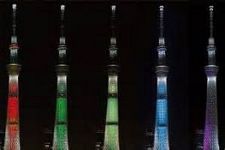 
[Sumida Fireworks]
December 10, 2014 09:00
This year was just 50 years since the Tokyo Olympics in 1964.
To commemorate that, events were held in various places, and special features were set up on TV programs, and something became a hot topic.
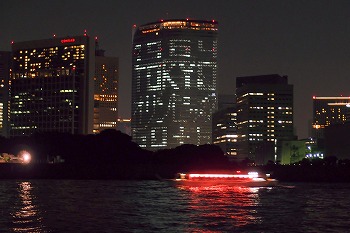 (Photo: October 11, 2014 Kachidoki, Chuo-ku, scenery of Shiodome on the opposite shore of Sumida River, 1964TOKYO Olympics 50th) (Photo: October 11, 2014 Kachidoki, Chuo-ku, scenery of Shiodome on the opposite shore of Sumida River, 1964TOKYO Olympics 50th)
In preparation for the Olympics, various transportation infrastructures such as Shinkansen, expressways, and monorails were being prepared.
In Chuo-ku, I think of the Metropolitan Expressway, which was built over Nihonbashi.
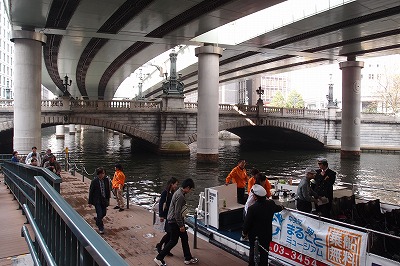 (Photo: Nihonbashi free cruise at the Marugoto Museum in Chuo-ku on November 2, 2014) (Photo: Nihonbashi free cruise at the Marugoto Museum in Chuo-ku on November 2, 2014)
Another other is the Tsukuda-ohashi Bridge, which was first bridged over the Sumida River after the war.
It wasn't very much taken up, though
Since it is opened in 1964, the same as the Olympics, this is also the 50th anniversary this year.
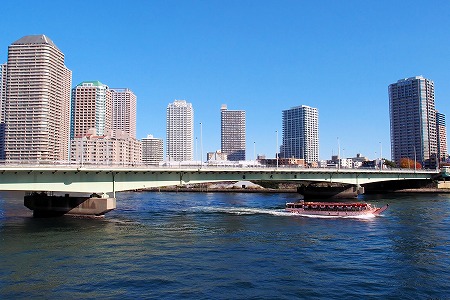 This time, I took up this bridge. This time, I took up this bridge.
This bridge connects Tsukuda Island and Tsukishima with Akashicho and central Tokyo, but it cannot be said that it has a very big feature in its appearance and shape.
However, in order to meet the Olympics, the bridge work was carried out at a rapid pace by combining the technologies of the time.
It can be said to be a symbol of Japan's high economic growth period when this bridge was built.
Before this bridge was built, the ship of Tsukuda's ferry, which was located at the same position as the bridge, was a citizen's foot.
It seems that this ferry was abolished at the same time as the opening of the bridge (August 27, 1964).
You can search for old images on the website of the Chuo City Library, but when I searched, I was able to find valuable photos from that time.
Link ⇒ Open Tsukuda-ohashi Bridge
This ferry on Tsukuda Island dates back to the rowing ferry in the early Edo period that connects Tsukuda Island and the city of Edo.
It was an event that ended with a history of 320 years.
Link ⇒ Ferry on Tsukuda Island
Many new historys have been created by the Olympics.
On the other hand, there were many things that were lost?
I looked for the remnants of this ferry around Tsukuda-ohashi Bridge.
The first is the monument of Tsukuda Island ferry on both banks of the Sumida River where the ferry was located.
 There are various changes in the ferry itself, but this monument was built in 1927 when the fare of the ferry operated by Tokyo City at the time became free. There are various changes in the ferry itself, but this monument was built in 1927 when the fare of the ferry operated by Tokyo City at the time became free.
The other is the "Lighthouse of Ishikawajima and the scenery of Tsukuda handing over" carved in the ranma of the basin (Omizuya) in Tsukuda Island and Sumiyoshi-jinja Shirine.
 If you are purifying your hand in the basin when you visit Sumiyoshi-jinja Shirine, please take a look at the top. If you are purifying your hand in the basin when you visit Sumiyoshi-jinja Shirine, please take a look at the top.
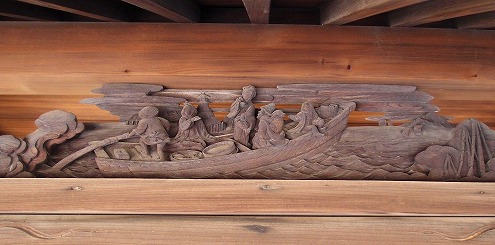 Each of the four sides of this building has sculptures related to different Tsukuda Island, one of which is "Ishikawajima Lighthouse and Tsukuda Passing Landscape". Each of the four sides of this building has sculptures related to different Tsukuda Island, one of which is "Ishikawajima Lighthouse and Tsukuda Passing Landscape".
It seems to have been carved in the Meiji era.
By the way, over the past 50 years, the environment and landscape around this bridge have changed, and the landscape from this bridge has changed every moment.
This Hashigami has an excellent sense of openness, so it has a good view and you can worship a very good landscape.
You can see the scenery of Chuo-ohashi Bridge and the Sky Tree in the upper reaches of the Sumida River.
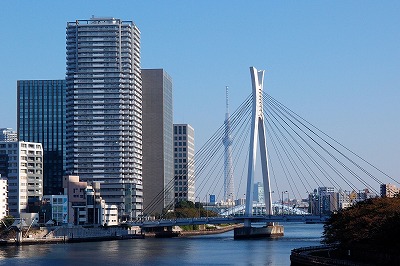 Of course, you can also see the streets of Tsukuda and the apartments in River City. Of course, you can also see the streets of Tsukuda and the apartments in River City.
And there are three arch bridges in the downstream area?
A new view has been added recently.
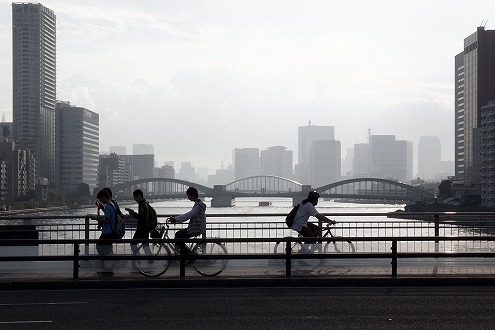 One arch of "Tsukiji Ohashi" formed at the lowermost stream of the Sumida River and two arches of "Kachidokibashi" in the foreground. One arch of "Tsukiji Ohashi" formed at the lowermost stream of the Sumida River and two arches of "Kachidokibashi" in the foreground.
There is a place on Tsukuda-ohashi Bridge that is similar in size and does not seem to overlap.
Did the people at the time of 1964 imagine the current landscape 50 years from now?
I can't imagine what the scenery will change in 50 years, but I hope that the good old scenes of Japan will remain.
[Nojinya]
December 9, 2014 14:00
The morning drama "Massan" modeled on the father of Japanese whiskey Masataka Taketsuru and Rita is very popular. I'm looking forward to seeing it every day, but today I would like to introduce Asa Dora's "Himi" (broadcast in 2008) set in Tsukishima and Tsukuda.
Hitomi Ippongi (20 years old), who plays the theme song by trombone player Eijiro Nakagawa and the opening of the bird's-eye view of Tsukuda and Tsukishima, is the main character Hitomi Ippongi (20 years old), who plays Nana Eikura, who aims to become a hip-hop dancer in Sapporo, started with her mother's Momoko, and she went to Tokyo for the funeral for the first time with her grandfather. My grandfather, Katsutaro, is a foster parent (Tokyo's nursing home system:
http://www.fukushihoken.metro.tokyo.jp/kodomo/satooya/seido/hotfamily/index.html)
He raises three foster children, led by junior high school students, but his eyes go to a dance school in Shibuya while living at his grandfather's home in Tsukishima as a young foster parent instead of his deceased grandmother.
The eyes, who looked at the balance between foster parents and dance, communicated with his grandfather Katsutaro and Satoko, and grew up with the support of the people of Tsukishima, despite various small incidents. On the other hand, at the dance school, dance aims to win the tournament by forming a unit with strong friends while dancing. 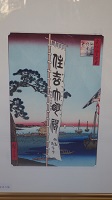 At the end of the tournament, the unit was dissolved, and the eyes that were attacked by a sense of weakness had grown their eyes with one woman while working at a cosmetics company until now, and now they have been transferred to the Tokyo branch office and work for a men and women of all ages. One day, a father who divorced Momoko with his grandfather Katsutaro appears in Sumiyoshi-jinja Shirine. 。 。 From the 25th week, the summer of Keijime, to the 26th week (final week), in the festival town, the drama is finally climaxing with the excavating a large banner, assembling the Sennuki Mikoshi, and the scene toward the day of Sumiyoshi-jinja Shirine Reitaisai festival. At the end of the tournament, the unit was dissolved, and the eyes that were attacked by a sense of weakness had grown their eyes with one woman while working at a cosmetics company until now, and now they have been transferred to the Tokyo branch office and work for a men and women of all ages. One day, a father who divorced Momoko with his grandfather Katsutaro appears in Sumiyoshi-jinja Shirine. 。 。 From the 25th week, the summer of Keijime, to the 26th week (final week), in the festival town, the drama is finally climaxing with the excavating a large banner, assembling the Sennuki Mikoshi, and the scene toward the day of Sumiyoshi-jinja Shirine Reitaisai festival.
[Sumiyoshi-jinja Shirine Grand Festival Large Nobori: Exhibited at Tsukuda Machikado Exhibition Hall]
In fact, unfortunately, the audience rating of "Eye" was quite low among NHK's past morning dramas, and it seems that it was a work that was very popular in the media and the Internet at the time of broadcasting. Although it is a personal impression, as a drama broadcast during the busy hours of morning such as going to work or going to school, it deals with slightly heavy topics such as foster parents and divorce of parents and rehabilitation, and slowly watch TV It may be the reason that the hurdles for viewers have been raised by the fact that hip-hop, which seems to be somewhat difficult to gain understanding for seniors who can watch. I enjoyed talking while drinking beer slowly at night, but it is recommended that this drama be relaxed and watched slowly. It's a total of 156 times, so don't let me know!
[New Year scenery of Sumiyoshi-jinja Shirine]
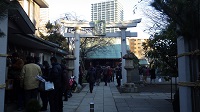
A lot of highlights of Chuo-ku appear in "Himi" set in Tsukishima and Tsukuda, where the atmosphere and human relationships of the downtown area remain strong. Katsutaro's Ippongi Western Shop and Tsukishima's alley scenery on Monja Street in Tsukishima where the eyes live, Chuo-ohashi Bridge and the eyes practice dancing, the Paris Square in Tsukuda where the eyes practice dancing, Sumiyoshi-jinja Shirine to Kachidokibashi, and Tsukiji Market. In addition, Tsukishima Minami Junior High School (without realism), which is set to go to Satoko's children, seems to have been filmed at Tsukuda Junior High School (Tsukuda 2-chome). The Reitaisai festival, including the imperial procession Funatogyo, can be seen in the drama, so I recommend it especially during the 25th and 26th week (Vol. 13 in DVD) . It seems that it has not been uploaded on NHK's on-demand, but it can be enjoyed on DVDs released by NHK Enterprises (some rentals are also available).
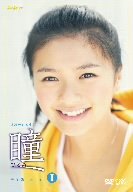
[The Eye] Released from DVD NHK Enterprises
[Nojinya]
09:00 on December 2, 2014
In the daytime, you can enjoy  the warm sunshine, but the season is completely winter. When the sun went down, it was a season when you could catch a cold unless you go out with a warm look. Today, I would like to talk the warm sunshine, but the season is completely winter. When the sun went down, it was a season when you could catch a cold unless you go out with a warm look. Today, I would like to talk  about literary works related to Chuo-ku as a recommendation for such a season. In June of this year, on the Chuo-ku sightseeing blog, we talked about Seicho Matsumoto's "Mujukujinbetsu Book" (Bunshun Bunko), set in the Ishikawajimajin Ashoba (/archive / author /ck1401 /), introduced as the second installment. It is Shugoro Yamamoto's "Sabu" (Shincho Bunko). about literary works related to Chuo-ku as a recommendation for such a season. In June of this year, on the Chuo-ku sightseeing blog, we talked about Seicho Matsumoto's "Mujukujinbetsu Book" (Bunshun Bunko), set in the Ishikawajimajin Ashoba (/archive / author /ck1401 /), introduced as the second installment. It is Shugoro Yamamoto's "Sabu" (Shincho Bunko).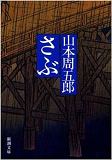
"In the evening when the light rain burst like a haze, the bust crossed Ryogoku Bridge from west to east, crying. On a twin-striped kimono, a thin corner belt of Kokura, a faded black front hanging, and wet from my head." The story that begins with the lonely appearance of Sabu, which is also the title of the book, goes with Sabu to Eiji, who works at Omogiya Yoshikodo in Nihonbashikobunacho. In the same age, the two who started serving together at the age of 12 were 20 years old, they were able to work well, and Eiji, who was in front of a man, was busy every day with the work of money exchange merchant cotton in Honmachi. I was sending, but one day suddenly my master gives my time. Eiji, who was suspected of being the culprit of the theft that occurred in cotton sentences, tried to clear the innocence, but he ate the front payment from the cotton sentence and, as a result, was put into the prison of Kitamachi magistrate . Eiji, who was desperate for the preparation from his trusted customer and master, closed his mouth at all for the interrogation and did not talk about his address or occupation, so he was considered an innocence person and was sent to the Ishikawajima folk vaudeville. I will. "This place does not consider the detainee as a sinner, those who have a job in their hands can swell in their jobs, and those who do not have a job can find their favorite job. They are paid for those tasks, and they will be the source of proper work when they come to the world." Eiji, who has not heard the explanation of the concentric of the venue, has also grown through various incidents that occur at the venue, fights, storm surges caused by typhoons, exchanges with officials and other detainees, and friendships of old knowledge who visit visits You. "The three years of the visit at the place have been more useful than 10 years in Shaba." After spending more than 200 pages in the visit, Eiji leaves the island and welcomes a happy ending, reveals the mystery of the theft, but let's make it fun to read.
Nowadays, high-rise apartments in Okawabata River City are lined up, and it is a place for people who leave a slight remnant at the monument of Ishikawajima Lighthouse in Tsukuda Park, but "Sabu" takes us to Nihonbashi and Ishikawajima in the Edo period . Why don't you travel around the town of Edo at Shugoro Yamamoto World while warming hot on a cold night?
1
|
Links
|



 ※2014/12/6 Shooting
※2014/12/6 Shooting
 ※Be careful of traffic because you can't see it unless you go on the road for half a step.
※Be careful of traffic because you can't see it unless you go on the road for half a step. ※2014/12/13 Shooting
※2014/12/13 Shooting





 (Photo: October 11, 2014 Kachidoki, Chuo-ku, scenery of Shiodome on the opposite shore of Sumida River, 1964TOKYO Olympics 50th)
(Photo: October 11, 2014 Kachidoki, Chuo-ku, scenery of Shiodome on the opposite shore of Sumida River, 1964TOKYO Olympics 50th) (Photo: Nihonbashi free cruise at the Marugoto Museum in Chuo-ku on November 2, 2014)
(Photo: Nihonbashi free cruise at the Marugoto Museum in Chuo-ku on November 2, 2014) This time, I took up this bridge.
This time, I took up this bridge. There are various changes in the ferry itself, but this monument was built in 1927 when the fare of the ferry operated by Tokyo City at the time became free.
There are various changes in the ferry itself, but this monument was built in 1927 when the fare of the ferry operated by Tokyo City at the time became free.
 Each of the four sides of this building has sculptures related to different Tsukuda Island, one of which is "Ishikawajima Lighthouse and Tsukuda Passing Landscape".
Each of the four sides of this building has sculptures related to different Tsukuda Island, one of which is "Ishikawajima Lighthouse and Tsukuda Passing Landscape". Of course, you can also see the streets of Tsukuda and the apartments in River City.
Of course, you can also see the streets of Tsukuda and the apartments in River City. One arch of "Tsukiji Ohashi" formed at the lowermost stream of the Sumida River and two arches of "Kachidokibashi" in the foreground.
One arch of "Tsukiji Ohashi" formed at the lowermost stream of the Sumida River and two arches of "Kachidokibashi" in the foreground.


